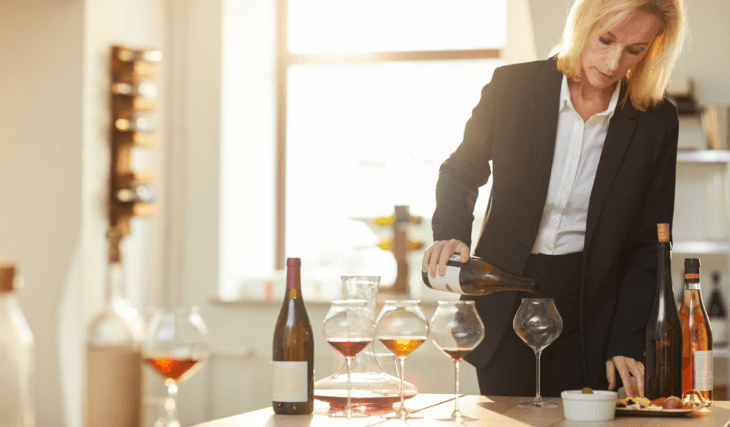Champagne Tasting Guide: How to Taste Champagne Like a Sommelier
The experience of tasting Champagne goes far beyond sipping bubbles at a celebration. True Champagne tasting involves a deep appreciation for aroma, structure, mouthfeel, and complexity—elements that sommeliers are trained to detect and evaluate with precision. For those looking to refine their palate and recognize notes like brioche, crushed stone, or citrus zest, learning to taste Champagne with intention is the first step toward a more meaningful experience. Whether exploring vintage bottles, non-vintage blends, or expressive rosés, understanding what defines quality can turn each glass into a moment of discovery.
From the first pop of the cork to the lingering finish, Champagne tasting engages all the senses. Evaluating color, effervescence, aroma, and flavor reveals the story of the wine—from its terroir and grape varieties to the winemaker’s craft and aging process. A methodical tasting process paired with a working knowledge of flavor profiles, glassware choices, and sweetness levels can elevate even casual sipping to a professional-level appreciation. With the right approach, every bottle becomes an opportunity to experience the nuance and depth that make Champagne unlike any other sparkling wine.
Preparing for the Perfect Tasting Experience
Before diving into aroma and palate, setting the stage is essential. Champagne should always be served chilled—ideally between 8 to 10°C (46 to 50°F)—to preserve its delicate structure and effervescence. Avoid over-chilling, as extremely cold temperatures can suppress aromas and dull the palate.
Choose a tulip-shaped or white wine glass rather than a traditional flute. While flutes are iconic, their narrow shape prevents the wine from fully releasing its aromatic complexity. Tulip glasses allow more surface area and space for swirling, enhancing your ability to smell and evaluate.
Lighting and environment matter as well. Taste Champagne in a neutral, scent-free space with natural lighting. Strong odors from food, candles, or perfumes can overpower Champagne’s subtle bouquet, while dim lighting makes it harder to assess visual cues like hue and bubbles.
Step-by-Step: How to Taste Champagne Like a Sommelier
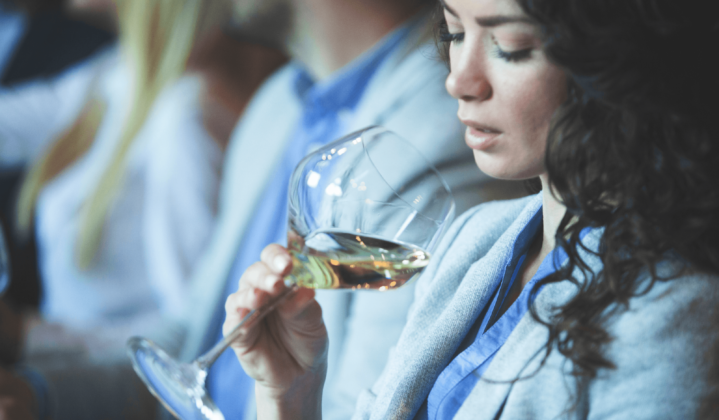
Observe the Appearance
Begin with a visual evaluation. Pour a small amount into your glass and hold it against a white background. Assess the color—ranging from pale straw to golden yellow for whites, or salmon to deep pink for rosés. Deeper colors may indicate older vintage Champagnes or those with longer lees aging.
Next, observe the bubbles. Fine, persistent bubbles rising in a steady stream suggest high quality and skilled fermentation. The mousse, or foamy head, should appear creamy and consistent when the Champagne is first poured.
Smell: Exploring the Aromatic Profile
Gently swirl the glass and inhale. Champagne aromas are typically grouped into three categories:
- Primary: From the grapes—notes of citrus, green apple, pear, or white flowers.
- Secondary: From fermentation and lees aging—aromas like brioche, almond, toast, or fresh bread.
- Tertiary: From aging—complex notes such as honey, mushroom, dried fruit, or truffle.
Take your time to explore these layers. Let the aroma linger and evolve in the glass.
Taste: Decoding the Palate
Sip slowly and let the Champagne coat your tongue. Sommeliers pay attention to:
- Acidity: Crisp and refreshing, acidity gives Champagne its lift.
- Sweetness: Balance varies by style—Brut is dry, Demi-Sec sweeter, and Extra Brut very dry.
- Mouthfeel: From creamy to chalky, texture offers key insight into the wine’s quality.
- Flavor: Expect continuity with the nose but also new layers—perhaps minerality, spice, or fruit compote.
- Finish: The lasting impression; a longer finish often indicates higher quality.
On the Palate: Savoring Champagne’s Depth
Acidity often appears first, awakening the senses before fruit, minerality, and subtle toast emerge. The mousse should feel elegant and well-integrated. Brut might reveal notes of lemon zest or almond, while rosé styles offer strawberry or rhubarb. Letting the wine breathe enhances depth—acidity softens, and tertiary flavors become more apparent.
Champagne stimulates all five senses. You see the sparkle, hear the signature pop, feel the texture, smell the bouquet, and taste its evolving complexity.
Types and Styles of Champagne
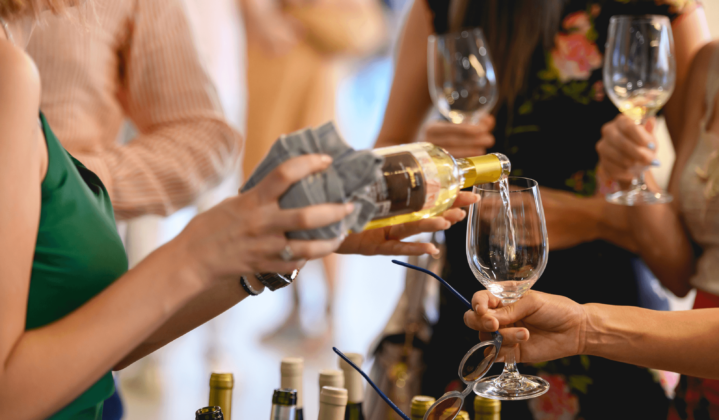
Types of Champagne
Blanc de Blancs Made exclusively from white grapes, usually 100% Chardonnay. Known for its bright acidity, finesse, and mineral finish, it’s perfect with seafood or as an apéritif.
Blanc de Noirs Produced from Pinot Noir and/or Meunier. Offers body, richness, and red fruit notes. Ideal for cooler weather and hearty meals.
Rosé Champagne Crafted through blending or the saignée method. Known for expressive fruit and floral notes. Pairs well with a wide range of dishes from grilled meats to desserts.
Prestige Cuvée Top-tier Champagne made in exceptional vintages. Often aged longer and crafted from the best grapes. Structured, refined, and built to age.
Champagne Grapes
- Chardonnay: Brings elegance and longevity.
- Pinot Noir: Adds structure and berry richness.
- Meunier: Offers roundness and early approachability.
Champagne Sweetness Levels
- Brut Nature (0–3 g/L): Bone dry
- Extra Brut (0–6 g/L): Very dry
- Brut (0–12 g/L): Dry and balanced
- Extra Dry (12–17 g/L): Slightly sweet
- Sec (17–32 g/L): Noticeably sweet
- Demi-Sec (32–50 g/L): Sweet and dessert-friendly
- Doux (50+ g/L): Very sweet
Understanding these levels helps in selecting Champagne to match your taste or meal.
How Champagne Differs from Still Wine Tasting
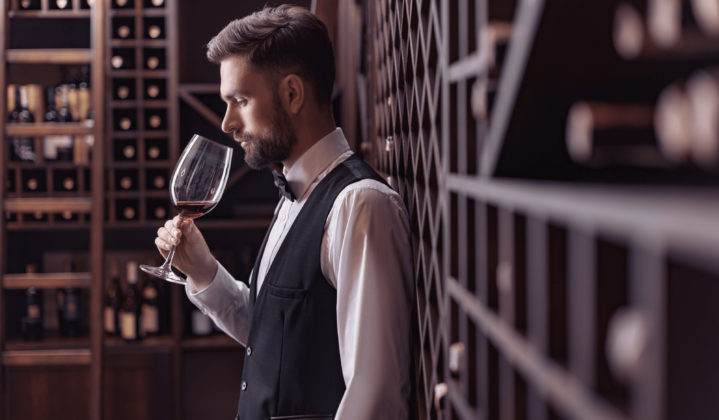
Champagne’s effervescence adds complexity. Bubbles lift aromas and create a tingling sensation, enhancing both texture and acidity. The traditional method of production—including secondary fermentation and lees aging—contributes layers of flavor rarely found in still wines. Every element, from mousse to minerality, is shaped by both winemaking technique and terroir.
This dynamic profile makes Champagne more interactive on the palate, with evolving layers that unfold differently with temperature and time. Its aging potential also sets it apart, as many fine Champagnes can develop beautifully over decades.
Why Bubbles Matter
Beyond visual appeal, bubbles aerate the wine and intensify aroma delivery. Fine streams of bubbles suggest skilled craftsmanship. Their behavior in the glass can reveal freshness, quality, and even the type of glassware used.
Bubbles also influence how flavors are perceived, acting as a vehicle that amplifies brightness and sharpens definition. The presence of lively carbonation keeps each sip feeling refreshing, even in richer or aged styles.
A Legendary Sound
While the iconic pop of Champagne signals celebration, professionals often aim for a soft sigh. This gentle release preserves pressure and prevents spillage—showing respect for the wine inside.
A controlled opening also minimizes agitation, allowing the wine to express itself gracefully from the very first pour. It’s a subtle yet telling sign of someone well-versed in Champagne etiquette.
Champagne Glassware and Serving Tips
Best Glasses: Tulip glasses allow aromas to concentrate while preserving effervescence. Flutes enhance presentation, while coupes are nostalgic but less functional.
The tulip shape also encourages a slow release of bubbles, offering a longer-lasting experience. Choosing the right silhouette can make a noticeable difference in how aromas and flavors are perceived.
Proper Handling: Always hold the glass by the stem to avoid warming the wine.
This also keeps fingerprints off the bowl, allowing you to better appreciate the wine’s clarity and color. It’s a small but essential part of preserving the sensory integrity of each pour.
Glass Material: Choose clear, thin-rimmed crystal or glass to fully appreciate Champagne’s color and texture.
Thinner rims offer a more seamless transition of the wine to the palate, enhancing the overall tasting experience. Avoid etched or colored glass, which can mask visual and aromatic subtleties.
Champagne Pairings and Occasions
Champagne pairs beautifully with a wide range of dishes. Its acidity and bubbles cut through fat and highlight flavor nuances. It complements both delicate and bold flavors, making it one of the most versatile wines at the table. Whether served at brunch or a formal dinner, its balance of freshness and complexity adapts effortlessly to the moment.
Ideal Pairings
- Oysters
- Sushi
- Fried chicken
- Truffle popcorn
- Brie or Camembert
- Caviar
- Duck
- Mushroom risotto
- Salted almonds
- Dark chocolate
Sweeter styles like Demi-Sec or Doux also work well with desserts, while Brut is a reliable apéritif.
You can even pair rosé Champagne with grilled meats or berry desserts for a more expressive match. When pairing, consider both texture and intensity to let the wine and dish elevate each other.
Buying, Opening, and Storing Champagne
Choosing Champagne
Consider the blend, vintage, dosage, and producer. Grower Champagnes offer unique expressions and exceptional quality.
Exploring lesser-known houses can lead to exciting discoveries that reflect specific terroirs and winemaking philosophies. Don’t hesitate to ask for recommendations based on your flavor preferences or occasion.
Sparkling Wine vs. Champagne
Only wines from the Champagne region using méthode champenoise can be called Champagne. Look for traditional method labeling for similar quality in alternatives like Cava or Crémant.
These wines undergo the same labor-intensive process and often offer incredible value. However, true Champagne retains a unique identity due to its climate, soil, and legacy of craftsmanship.
Opening Champagne
Chill properly. Remove the foil, loosen the cage, and hold the cork firmly. Tilt the bottle at 45 degrees and twist gently from the base. Aim for a whisper, not a bang.
Keeping one hand on the cork at all times ensures safety and control. Serving the wine immediately after opening helps maintain its ideal temperature and effervescence.
Storage Tips
Store bottles on their side in a cool, dark place (around 12°C). Avoid storing in the fridge long-term, as vibration and dryness can compromise the cork. Use a wine fridge or cellar for aging.
Humidity levels should remain stable to prevent cork shrinkage, which can lead to oxidation. For long-term storage, avoid exposure to light, which can degrade both flavor and aroma over time.
Tips from Professional Sommeliers
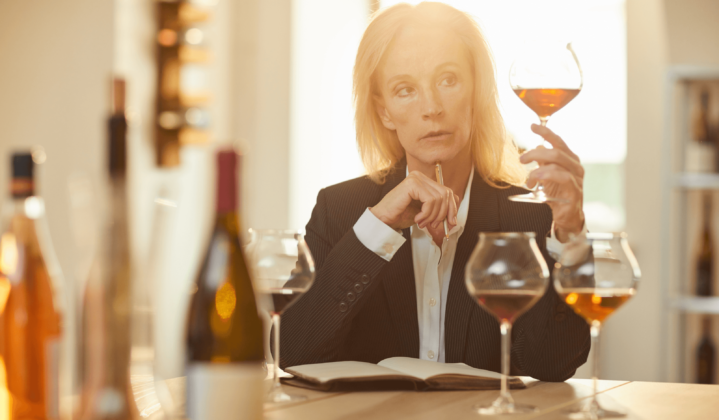
- Use a Tasting Grid: Track appearance, aroma, palate, and overall impression to sharpen sensory skills. It helps develop a vocabulary and structure for evaluating wine consistently.
- Taste in Sequence: Begin with lighter styles, move to richer vintages, and end with rosés or sweeter expressions. This prevents palate fatigue and allows each wine to be appreciated fully.
- Pair Thoughtfully: Taste Champagne with various foods to explore how flavors evolve. Even unexpected combinations can reveal new dimensions of the wine.
- Keep a Journal: Document your experiences—over time, patterns and preferences will emerge. Include context like occasion, company, and pairing to deepen your insights.
Final Sip on How to Taste Champagne Like a Sommelier
Tasting Champagne like a sommelier is a journey of attention and appreciation. It’s about engaging your senses, understanding structure, and honoring the craftsmanship behind each bottle. With knowledge and curiosity, every glass becomes more than a drink—it becomes an experience.
As your palate matures, you’ll find joy not only in the Champagne itself but in the stories and moments it enhances. A thoughtfully chosen accessory—like a beautifully crafted saber or proper glassware—can enrich the experience, making each tasting feel even more intentional and memorable.
Frequently Asked Questions
How should Champagne be stored long-term?
Champagne should be stored horizontally in a cool, dark place with stable temperatures—ideally around 12°C. A dedicated wine fridge or cellar is best, as it also protects against vibrations and dryness that could compromise the cork.
What’s the best way to identify Champagne quality by taste?
Pay attention to the balance between acidity, fruit, and texture. Fine bubbles, layered aromas that evolve in the glass, and a clean, lingering finish are strong indicators of quality. A well-crafted Champagne should feel harmonious rather than sharp or flat.
Which Champagne type pairs best with seafood or dessert?
For seafood, Blanc de Blancs is ideal due to its bright acidity and mineral edge, which complement delicate ocean flavors. When it comes to dessert, Rosé Champagne or Demi-Sec works beautifully—offering fruitiness and sweetness that align with pastries, fruit tarts, or chocolate.
What makes a cuvée “prestige”?
A prestige cuvée is the flagship wine of a Champagne house, made only in exceptional vintages with the best grapes—often from Grand Cru vineyards. These wines are typically aged longer, resulting in greater complexity, structure, and depth, and are meant to showcase the producer’s highest craftsmanship.
Is there a noticeable taste difference between glassware styles?
Yes, the shape of the glass significantly influences aroma release and bubble behavior. Tulip glasses offer the best of both worlds, preserving effervescence while allowing aromas to open. Flutes maintain visual appeal and fizz but limit aromatics, while coupes tend to mute both aroma and sparkle quickly.
